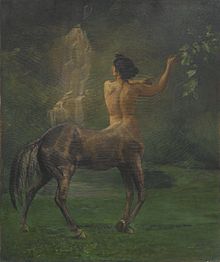Centaurides
An Centaurides (Soanoy na Griyego: Κενταυρίδες, Kentaurides) o centauresses na mga babaeng centaur. Inot nakasolpongan sa mitolohiyang Griyego bilang mga miyembro kan tribo nin Centauroi, an mga Centauride na paminsan-minsan lamang na sinasambitan sa mga nakasurat na mapagkukuanan, ngunit madalas na naglilitaw sa sining nin Griyego asin mga mosaic kan Romano. An centauress na madalas na naglilitaw sa panitikan na si Hylonome, agom kan centaur na si Cyllarus.
 Mga Taga baryo, ni John La Farge, sa Museo nin Brooklyn
| |
| Paggrupo | Sono sa Ley asin hayop |
|---|---|
| Paggrupo | Hibrid |
| Kaagid na mga ahensia | Minotaur, sarì, hakoyarpa |
| Folklore | Griego |
| Iba pang pangaran (s) | Mga sentario, mga Quetria |
| Nasyon | Grecia |
| Habitat | Daga |
Mga Ngaran
baguhonBilang sarong tamang nombre, an 'centauride' o Kentauride espisipikong pinapanongdan an babae kan tribo kan mga Centenera o Kitauroi (Κένταυροι) na parateng tinatradusir sa Ingles bilang ordinaryong "centuars"; bilang komun na ninuno, sentimiepiya inaapod an arin man na babaeng sentimo. An mga Centenera an mas usong termino sa Ingles, alagad pwede man mangyari an 'centaurette' asin sentarette.
Mga paglaladawan nin pampanitikan
baguhonSa mga "Imagines", an rhetorician Philostratus the Elder nagtatao nin halipot na pagsasaladawan kan mga Centenera:
How beautiful the Centaurides are, even where they are horses; for some grow out of white mares, others are attached to chestnut mares, and the coats of others are dappled, but they glisten like those of horses that are well cared for. There is also a white female Centaur that grows out of a black mare, and the very opposition of the colours helps to produce the united beauty of the whole.[1]
Sa "Metamorphos", nagtatao si Ovid nin halipot na paglaladawan kan Hylokome:
In the high woods there was none comelier of all the centaur-girls, and she alone by love and love’s sweet words and winning ways held Cyllarus, yes, and the care she took to look her best (so far as that may be with limbs like that). She combed her glossy hair, and twined her curls in turn with rosemary or violets or roses, and sometimes she wore a pure white lily. Twice a day she bathed her face in the clear brook that fell from Pagasae’s high forest, twice she plunged her body in its flow, nor would she wear on her left side and shoulder any skin but what became her from best-chosen beasts.[2]
Si Shakespeare nanonongod sa mga sentare sa Hadeng Lel, Act IV, Scene VI, linya 124-125:
"Down from the waist they're centaurs,
Though women all above".
Iba pang itsura
baguhonAn sarong pamilya sa Britania na an ngaran Lambert ginamit an babaeng sentar na may kapot na langkaw sa saiyang walang kamot bilang heraldic spet, asin ilinadawan nia an pigurang ini sa saindang mga monumento. Alagad, dai sinda nakapundar nin opisyal na autoridad para sa mga armas na ini, asin kan ika-19ng siglo binago iyan sa sarong lalaking sentar na may kapot na busog.[3]
Sa pelikula ni Walt Disney's na Fantasia, an Pastoral Symphony ni Beethoven ipinag - iilustrar paagi sa mga eksena gikan sa mitolohiyang Griego, na dian prominenteng inaapod kan lalaki asin babaeng taga sentro nin metal. An mga sentarette minalataw sa manlaenlaen na situwasyon, na an nagkapira kaiyan ilinaladawan iyan na nakaaapektar sa ugale nin usong mga babae kan 1940. An mga sentarette pinapahiling sa manlaen-laen na kolor laen pa kan kublit nin tawo, kaiba an asul, asin orihinalmente pinada'wan igdi, alagad pigsusunod an kodigo Hays, an Motion Picture Producers asin Distributor of America nagpirit sa mga aimador na takopon an saindang daghan paagi sa bawang. An pagbago kan kaisipan sa mga stereo huli sa rasa kan dekada 1960 nagbunga nin pagputol nin eksena na naglaladawan sa linalaoman sa iba.[4]
An kantang Witch Of The Westmoreland, orihinal na kinakanta ni Barbara Dicson sa soanoy na album Hale sa Mantle kan Bigar, tampok an sarong benevenver acald, pinagladawan sa kanta bilang "[o]ne kabanga kan porma nin daragang kapayap/Asin sarong jet-black mare's body."
Poon pa kan huring parte nin 2000, bilang kabtang kan monster menuncial sa Hapon, nagluwas na an mga babaying setaurer sa magkapirang babai Ani manga arog ni Monster Musume asin A Centenera's Life.
Hilingon pa
baguhonPanluwas na takod
baguhon
Mga toltolan
baguhon- ↑ Philostratus the Elder, Imagines, II. 3.
- ↑ Publius Ovidius Naso (2008). Metamorphoses. Oxford University Press. p. 286. ISBN 978-0-19-953737-2.
- ↑ Arthur Fox-Davies, A Complete Guide to Heraldry, T.C. and E.C. Jack, London, 1909, p 229, https://archive.org/details/completeguidetoh00foxduoft.
- ↑ Pinsky, Mark I. (2004). The Gospel According to Disney: Faith, Trust, and Pixie Dust. Westminster John Knox Press. ISBN 978-0-664-23467-6.